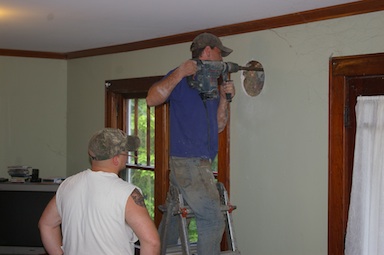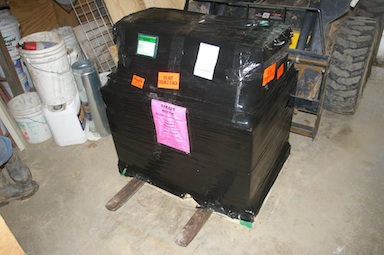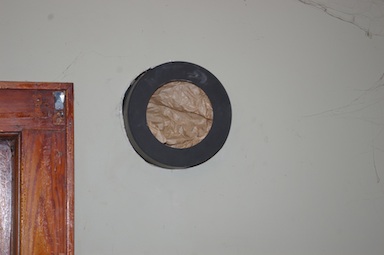May 26, 2012
Wood stove, Part I
When I first looked at this house, there was a woodstove in the livingroom. It belonged to the tenants, and they were willing to sell it - but my ex-wife was allergic to wood smoke and really didn't want a wood stove in the house. It went, and the only reminder of it was a board over a hole in the wall that we eventually replaced with new sheetrock.
After a few years, it was clear that the wood stove had been the only way to keep heating costs sane in this largely uninsulated house with an inefficient octopus furnace. Prior residents seem to have thought the same.
We cut our natural gas use by about 60% by replacing the furnace with a new one and insulating the house. A few years later, I replaced the aging water heater with a new on-demand heater, and our bills dropped again. I did install a gas cooktop in 2006, replacing an ancient and beautiful but barely functional electric stove, so there's been one fairly small new use of natural gas added to the house while I've been here.
There are a few problems even with the new setup, however:
We need electricity for the furnace, hot water heater, and cooking. Sure, they're gas, but they also need electricity. (Well, yes, I can light the stove with matches if needed, but I don't think the stove will keep pipes from freezing, at least not safely.) I've had fewer power outages at the house for the past few years, but when I moved in, power went out a few times a year. It also seems that we've been luckier with weather than points a little further south, and I'm not counting on that to continue.
The hot water sometimes goes cold in the middle of a shower. Why? Because the hot water heater draws a lot of gas when it's running - and if the heat or the stove are on, it wants to draw more gas than the current connection provides. For our safety, it shuts down. I did call NYSEG about getting a bigger line (or replacing the meter, which may be the limiting factor), but I'm not really enthusiastic about adding gas-consumption capacity to the house, even for short bursts. We haven't expanded the line.
The furnace and the water heater are complex electronic devices. I'd like to think that the parts warehouses will hold their components forever, but based on prior repairs of electronics in appliances, I have my doubts.
I had hoped a few years ago that solar might be an answer, and it probably will be eventually as I slowly clear trees away from my house, but the early tests for hot water and electricity from my roof weren't promising.
Instead, inspired a bit by our recent acquisition of woodland, we're going to install a woodstove. The woodstove we've chosen - which I first saw at Town Supervisor Mary Ann Sumner's house - is a Waterford Stanley cookstove that can also heat hot running water. (Mary Ann didn't go for the hot running water option years ago.) On a sentimental note, Waterford Stanley's stove factory isn't far from the area where my mother's family came from.
This choice is somewhat complicating, as only one place sells these, and it's in Ohio. I didn't find most of our local wood stove installers very excited about working with a stove they didn't sell. (Of course, given the difficulties I've had getting contractors to call me back, some of them may not even have reached that point.)
Fortunately, the folks at Holy Smoke Stove Fireplace and Chimney were familiar with the stove - the owner of the company has one in his house. They were fine with installing it, and enthusiastic about stoves that provide water and cooking as well as heat. They also were willing (for a small extra fee) to take delivery of the 800-pound package.
(In the past I've had tractor trailers deliver to the Orchid Place (formerly Boxcar) parking lot, and then I've carried things up my driveway. While the folks at The Duke Company were willing to rent me a forklift for this, they also wisely asked me about my driveway - which isn't nearly as smooth as the forklift would like.)
It doesn't look like much yet, but the stove arrived a couple of weeks ago. (We're still waiting for the hot water component, which would be a lot easier to install before the stove goes in.)
We're putting the stove, despite its cooking powers, in the same place where the previous wood stove was in the living room, using the chimney that's already on the front of the house. This is a somewhat complicated location because the front door is right there, but the distances work out. It might be nice to put it in the kitchen, and using the chimney there, which seems to have been the original (1929-195?) configuration of the house, but that would mean ripping out and rebuilding the kitchen. I'd like to do that, but it's far too large a project for our funds, and I'm not sure that doing it while the kids are 2 and 4 is a great idea. Maybe eventually we'll move it.
Jared and Jesse came yesterday to work on the connection to the chimney. They worked from the inside of the house, cutting, drilling, and breaking a new hole to the chimney, and installing a thimble. It's a little higher than the old connection, but it all went smoothly.

Jesse cuts the hole for the thimble.
There's still a lot more to do. They'll be installing a stainless steel liner in the chimney, something I had doubts was necessary but seems to help with our slightly too complicated stovepipe plan. We still need to install a hearth to go under the stove, and we've picked out stone at Tile-Tec for that. Once the hearth and liner are in, we can move on to the stove itself and the connections to the chimney. Finally, we'll need to connect the hot running water piece to the plumbing.
(The water from the stove will still run through our on-demand gas water heater, which won't turn on if the water coming into it is already hot. In summer, when the stove is likely off, the gas heater will likely do the work until we can get a solar hot water heater installed.)
I'm not planning to rip out my natural gas infrastructure any time soon, but hope that adding the stove will reduce our consumption by about another two-thirds, and break our dependency on electricity and gas to keep the house functioning.
I've also posted a gallery of images of the installation so far.
More to come!
Note on photos

